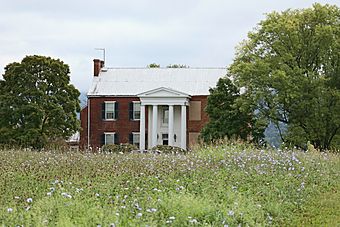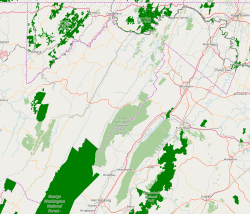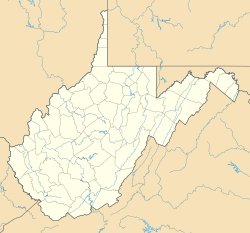Fort Pleasant facts for kids
Quick facts for kids |
|
|
Fort Pleasant
(Isaac Van Meter House) |
|

The Isaac Van Meter House (c. 1780s-90s) in 2020
|
|
| Location | Old Fields north of Moorefield, West Virginia |
|---|---|
| Built | late 18th century |
| Built by | Isaac Van Meter |
| Architectural style | Federal |
| MPS | South Branch Valley MRA |
| NRHP reference No. | 73001903 |
| Added to NRHP | July 16, 1973 |
Fort Pleasant is a historic place located near the community of Old Fields in Hardy County, West Virginia, U.S. It is about 5 miles north of Moorefield. This site has been known by several names over time, including Fort Van Meter, Town Fort, and the Isaac Van Meter House.
The fort sits on the South Branch Potomac River. In 1756, during the French and Indian War, a young Colonel George Washington ordered a fort to be built here. A fierce battle called the Battle of the Trough happened nearby in the same year. The house that stands there today was built after the American Revolution. It was added to the National Register of Historic Places in 1973.
Fort Pleasant was also sometimes called "Fort Hopewell" or "Waggener's Lower Fort." This helped tell it apart from another fort, "Fort Buttermilk," which was also built by Captain Waggener. The name "Fort Van Meter" is now often used for a different Van Meter family fort about nine miles downstream.
Contents
History of Fort Pleasant
Early Settlement (1740s)
The area around Fort Pleasant was first settled in 1744 by Isaac Van Meter (born around 1692) and his family. They built a strong log cabin there.
When he was a teenager, George Washington visited this area, then known as "Indian Old Fields." He met Isaac Van Meter in 1747-48 while surveying land for Lord Fairfax. Washington noted that Van Meter claimed his land based on grants from the Virginia Governor's Council. This was different from Fairfax's land grant. The land dispute continued for many years, even after the American Revolution. Eventually, the Van Meter family won the case.
French and Indian War (1750s)
In 1756, at the start of the French and Indian War, a large new fort was built on Isaac Van Meter's land. Captain Thomas Waggener built it under orders from Colonel George Washington. The fort was first named after the Van Meter family, who helped build and maintain it.
It was a strong defense with a palisade (a fence of strong wooden stakes). Inside, it had a blockhouse and log houses. Washington's plans show it was a square shape with 90-foot-long walls and corner towers. Fort Pleasant was part of a chain of forts along the frontier. For a time, it was the main base for the Virginia Regiment in the South Branch area.
The fort was never directly attacked by Native Americans. However, several raids happened nearby. Soon after the fort was built, the Battle of the Trough (1756) took place a short distance north. In 1757, Isaac Van Meter was attacked and killed by Native Americans from the Delaware and Shawnee tribes while working in his fields.
Changes and New Buildings (1770s & 1780s)
A map of Fort Pleasant from May 1770, signed by James Witt, shows blockhouses at the fort's corners. This suggests the fort was either updated or completely rebuilt after the French and Indian War ended.
After the town of Moorefield was founded to the south in 1777, the fort became known as "Town Fort." This was because it was close to the new town. When George Washington visited the area for the last time in 1784, he noted that the Fort Pleasant blockhouse was still standing.
Later, Isaac's son, Garrett Van Meter (1732-1788), had most of the old fort and the original family cabin removed. In their place, he built a strong brick structure for defense. This building was half above ground and half below. Parts of this unique structure still exist today.
The "Great House" (1790s)
The large brick house at Fort Pleasant was finished by Garrett's son, Isaac B. Van Meter (1757-1837), and his wife Elizabeth. It was completed before the end of the 18th century. This house was built on the exact spot of the old fort. Because of this, both the fort and the house shared the name "Fort Pleasant."
This impressive home is a huge Federal-style building with two large chimneys. It was built using clay bricks made right on the Fort Pleasant farm. Its tall columns, which span two stories, were some of the first of their kind in the region. Fort Pleasant became known as one of the "great houses" of the South Branch Valley.
Later Years (19th century)
It seems that a part of the old fort remained even after Garrett Van Meter's changes and the building of the "great house." When Samuel Kercheval (1767-1845), a local historian, visited the site in 1830, he wrote that "one of the block-houses, with portholes was still standing." He also noted that the logs were "particularly sound." This means the last parts of the old fort did not disappear until later in the 19th century.
Other Van Meter Homes
Fort Pleasant is one of five important Van Meter family homes in the Old Fields area. The others are Traveler's Rest, Fort Van Meter, the Garrett VanMeter House, and Buena Vista Farms.





